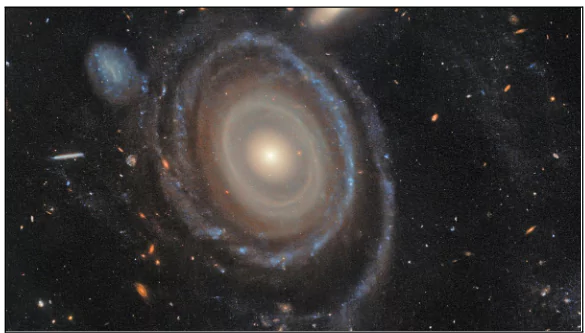Recently, astronomers reported the discovery of the rare Bullseye Galaxy, a unique structure offering new insights into dark matter and galactic evolution, in The Astrophysical Journal Letters.
Key Highlight of the Discovery
- The Bullseye Galaxy is the first known galaxy with nine visible rings; most ringed galaxies typically have only two or three.
- This discovery was termed “serendipitous” due to its rarity and the unique features it revealed.
- The Hubble Space Telescope identified eight rings, while a ninth was confirmed using data from the W.M. Keck Observatory in Hawaii.
- Astronomers speculate that a tenth ring may have existed but has faded.
About the Bullseye Galaxy

- Officially designated as LEDA 1313424, the Bullseye Galaxy is approximately 2.5 times the size of the Milky Way, spanning 250,000 light-years in diameter.
- Formation of rings: Formed after a blue dwarf galaxy passed directly through its center about 50 million years ago.
- This collision sent ripple-like waves of gas through the galaxy, which triggered new star formation in ring patterns.
- The dwarf galaxy is still seen in the galaxy’s vicinity, separated by 130,000 light-years, and connected by a thin gas trail.
- Life of the rings: They are temporary structures and are expected to fade away over billions of years, potentially leaving behind a different kind of galaxy.
- It also contains signs that it could one day evolve into a giant low surface brightness (GLSB) galaxy, which are important in the study of dark matter.
About Low Surface-Brightness (LSB) Galaxies
- LSB galaxies have faint stellar disks, with lower-than-expected brightness and minimal star formation.
- Despite having abundant hydrogen, the fuel for star formation, these galaxies produce few stars.
- LSB galaxies typically have less dense central regions, which contradicts the standard cosmological model that predicts denser galactic cores.
- They are believed to be dominated by dark matter, making them important targets in dark matter research.
- A prevailing theory suggests their dark matter halos rotate rapidly, causing the matter to spread outward like clay on a potter’s wheel, reducing disk density and stifling star formation.
About Giant Low Surface-Brightness (GLSB) Galaxies
- GLSB galaxies are the largest class of LSB galaxies and are structurally vast.
- Malin 1, a known GLSB galaxy, is about 6.5 times wider than the Milky Way.
- These galaxies contain large neutral hydrogen disks and diffuse stellar disks.
- They often harbor smaller central black holes, suggesting they are less evolved than typical galaxies.
- The Bullseye Galaxy shows traits, such as extended hydrogen-rich disks and low stellar density similar to GLSB galaxies.
- However, most GLSBs are found in isolation, making the collisional origin of the Bullseye unique.
- If confirmed, the Bullseye could offer the first observational link between a collisional ring galaxy and a future GLSB galaxy.
Significance of the Discovery
- The study opens new avenues to understand how galaxy collisions may lead to LSB and GLSB galaxy formation.
- Confirming this connection could refine our cosmological models and offer insights into the behavior and distribution of dark matter in the universe.
- Further observations and cosmological simulations will be essential to test and validate these findings
![]() 22 Apr 2025
22 Apr 2025


